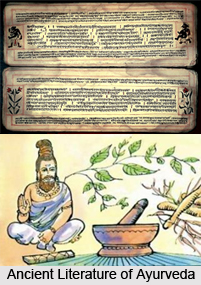 Ancient Literature on Ayurveda shows that, it was a comprehensive practical science in which the causes of disease as well as the treatments were given due consideration. It is said that Brahma imparted "Veda" i.e. knowledge for the benefit of mankind. In the Vedic ages the medical science was known as "Ayurveda". Many historians claim that, during that time Ayurveda was of the highest order and even better than the concept of medicine in ancient Babylon and Egypt.
Ancient Literature on Ayurveda shows that, it was a comprehensive practical science in which the causes of disease as well as the treatments were given due consideration. It is said that Brahma imparted "Veda" i.e. knowledge for the benefit of mankind. In the Vedic ages the medical science was known as "Ayurveda". Many historians claim that, during that time Ayurveda was of the highest order and even better than the concept of medicine in ancient Babylon and Egypt.
Origin of Medicine in Vedas
Vedas were verbal transmissions related to philosophy, religion, medicine, astronomy and other faculties. There were four Vedas, like "Rig", "Sama", "Yajur" and "Atharva". It is said that most of the medical ideas of the Vedic ages are to be found in the last of the Vedas that is the "Atharva Veda".
Ancient Texts on Medicine
In the mythological element of Ayurveda it is said that, the Prajapaties (disciples of Brahma) gave away their knowledge to the two Awinikumaras. It is said that, in a later period the verbal advices of Brahma were compiled into a treatise called "Brahma Siddhanta" which contained certain medical therapy.
According to the Vedas, Dhanwantari was the promoter of surgery. Before Sushruta and Agnibesha, Ayurveda used to be propagated verbally. Sushruta learnt surgery from Dhanwantari. Maharishi Agnibesha wrote a book on medicine, named, "Agnibesha Samhita". The "Sushruta Samhita" was well ahead of Agnibesha. The principal teacher of Agnibesha was Charaka who composed "Charaka Samhita".
Practice of Ancient Indian Medicine
In the practice of ancient Indian medicine there were 2 different streams; one was introduced by Dhanwantari and the other by Atreya. The medicinal therapy in the Vedic ages was subdivided into 2 categories: one was called "Rasha Sadaka" meaning treatment with the help of chemicals like mercury (parada), sulphur (gandhaka), copper (tamra) etc. and the other was "Visa Sadaka". In that method the physicians treated their patients with the help of various poisonous substances like snake venom in measured doses. The Visa Sadaka Chikitsa was later called "Tantra Chikitsa".
The Ancient Ayurveda was divided into 9 chapters:
1. Kaya Chikitsa: Medicinal Therapy
2. Salya Chikitsa: Surgical Therapy
3. Salakya Chikitsa: Treatment of Eye, Ear, Nose and Throat diseases and Plastic surgery
4. Bhuta Vidya: Psychiatry
5. Kumdra Vrtya: Paediatrics and infant hygiene
6. Agoda Tantra: Toxicology
7. Bajikaran Tantra: Sexology
8. Rasayan Tantra: Chemical Therapy
9. Pasu Chikitsa: Veterinary medicine
Besides those there were treatises on contemporary hypothetical anatomy and functions of various internal organs, but the anatomical studies were conceptual not factual. The science of dietetics was also considered to be a very important constituent of Ayurveda.
Some Famous Medical Personalities of the Vedic Ages
For famous physicians of the Vedic age one must mention the names of "Aswini Kumaras". In the Rig Veda and other Puranas the Aswini Kumar twins have been deified by equating them with Indra, Agni and Soma. In the same way those names were also mentioned in "Zend Avesta", the great religious book of the fire-worshipping Persians. It is said that they were born of the wife of Surya; the Sun God while she was roaming about in the guise of a mare and was impregnated by Surya in the disguise of a horse. At many places in Rig Veda, the skill of Aswini Kumaras has been described claiming that they could treat and cure most of the human ailments, even brain tumours. Some later learned analysts of the Vedas claimed that Aswini Kumaras were human beings. Because of their exceptional skill all doctors and people were enamoured and treated them like God. One of the Aswini Kumaras used to treat with the help of chemicals and the other one used to treat with help of rays or rashmis. Some asserts that those two doctors were nothing but two variants of the rays of the Sun.
The second famous physician was "Dhanwantari". He was also described in the Rig Veda as a "Deva Vaidya" as he treated the Gods. His mythical birth happened during the churning of the ocean at the command of Vishnu. He was also called "Abja" as he was born out of water. In a later birth he was born to preach "Astanga Ayurveda Shastra" on the earth.
Related Articles
Primitive Medicinal Practices in India
Indian Naturopathy
Ancient History of India
Ayurveda
Sushruta
Sushruta Samhita
Charaka Samhita
Indian Medicinal Plants
Traditional Indian Medicines




